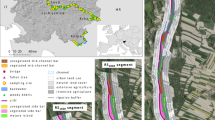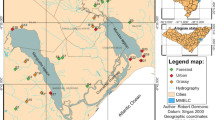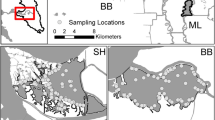Abstract
Context
Untangling relationships between landscape patterns shaped by human stressors and related response of fish communities is important for identifying biodiversity patterns and conservation targets, yet in large rivers this knowledge is extremely limited.
Objectives
Our study focuses on how human stressors within a riparian landscape zone, including both riparian land use and in-channel stressors, explained the fish community structure in a large river.
Methods
We studied fish community patterns along the upstream-downstream gradient of the Yangtze River, China. The curve estimation was used to test correlations between fish metrics and the distance from the estuary. We linked human stressors to fish metrics by multivariate generalized linear models.
Results
We collected a total of 63 freshwater fish species from 6,147 specimens. Limnophilic species had the highest richness, represented by 30 specie. The predominant riparian land uses in the studied reaches were cropland (65.3% ± 13.1%) and urban land (19.7% ± 13.6%). There were strong negative correlations between riparian land use (e.g., urban land) and in-channel stressors (e.g., shoreline modification, navigation, and fishing pressure) and fish assemblages, especially limnophilic fish abundance, biomass, and richness.
Conclusions
These results demonstrate influences of both riparian land use and in-channel stressors on fish communities, and highlight the use of landscape descriptors as a valuable approach to assess linkages between human pressures and fish diversity in large river systems. Management recommendations include: establishing or rehabilitating riparian buffers, improving commercial navigation management, implementing shoreline protection measures, and reinforcing fishing laws and regulations.




Similar content being viewed by others
Data availability
After publication, all data related to this manuscript will be available on-line at the Data Center of Institute of Hydrobiology, Chinese Academy of Sciences: www.ihb.ac.cn.
References
Allan JD (2004) Landscapes and riverscapes: the influence of land use on stream ecosystems. Annu Rev Ecol Evol Syst 35:257–284
Allan JD, Abell R, Hogan Z, Revenga C, Taylor BW, Welcomme RL (2005) Overfishing of Inland Waters. Bioscience 55:1041–1051
Anderson MJ (2001) Permutation tests for univariate or multivariate analysis of variance and regression. Can J Fish Aquat Sci 58:626–639
Arantes CC, Winemiller KO, Petrere M, Castello L, Hess LL, Freitas CEC (2018) Relationships between forest cover and fish diversity in the Amazon River floodplain. J Appl Ecol 55:386–395
Becker A, Whitfield AK, Cowley PD, Järnegren J, Næsje TF (2013) Does boat traffic cause displacement of fish in estuaries? Mar Pollut Bull 75:168–173
Bhat A, Magurran AE (2006) Taxonomic distinctness in a linear system: a test using a tropical freshwater fish assemblage. Ecography 29:104–110
Boddy NC, Booker DJ, McIntosh AR (2019) Confluence configuration of river networks controls spatial patterns in fish communities. Landscape Ecol 34:187–201
Burgin S, Hardiman N (2011) The direct physical, chemical and biotic impacts on Australian coastal waters due to recreational boating. Biodivers Conserv 20:683–701
Burrell TK, O’Brien JM, Graham SE, Simon KS, Harding JS, McIntosh AR (2014) Riparian shading mitigates stream eutrophication in agricultural catchments. Freshw Sci 33:73–84
Chen K, Olden JD (2020) Threshold responses of riverine fish communities to land use conversion across regions of the world. Glob Change Biol 26:4952–4965
Chen Y, Chapman D, Jackson J, Chen D, Li Z, Kilgore J, Phelps Q, Eggleton M (eds) (2016) Fisheries resources, environment, and conservation in the Mississippi and Yangtze (Changjiang) River basins. American Fisheries Society, Symposium 84, Bethesda, Maryland
Chen Y, Qu X, Xiong F, Lu Y, Wang L, Hughes RM (2020) Challenges to saving China’s freshwater biodiversity: fishery exploitation and landscape pressures. Ambio 49:926–938
Chen Y, Zhang S, Huang D, Li BL, Liu J, Liu W (2017) The development of China’s Yangtze River Economic Belt: how to make it in a green way? Sci Bull 62:648–651
Comte L, Olden J (2017) Climatic vulnerability of the world’s freshwater and marine fishes. Nat Climate Change 7:718–722
Comte L, Olden J (2018) Evidence for dispersal syndromes in freshwater fishes. Proc R Soc B Biol Sci 285(1871):20172214
Costello C (2017) Fish harder; catch more? Proc Natl Acad Sci USA 114:1442–1444
Clarke KR, Warwick RM (1998) A taxonomic distinctness index and its statistical properties. J Appl Ecol 35:523–531
Dala-Corte RB, Giam X, Olden JD, Becker FG, Guimarães TF, Melo AS (2016) Revealing the pathways by which agricultural land-use affects stream fish communities in South Brazilian grasslands. Freshw Biol 61:1921–1934
Dosskey MG, Helmers MJ, Eisenhauer DE (2006) An approach for using soil surveys to guide the placement of water quality buffers. J Soil Water Conserv 61:344–354
Dutta V, Sharma U, Iqbal K, Adeeba, Kumar R, Pathak AK (2018) Impact of river channelization and riverfront development on fluvial habitat: evidence from Gomti River, a tributary of Ganges, India. Environ Sustain 1:167–184
Forman RTT, Godron M (1986) Landscape ecology. Wiley, New York
Frissell CA, Liss WJ, Warren CE, Hurley MD (1986) A hierarchical framework for stream habitat classification: viewing streams in a watershed context. Environ Manage 10:199–214
Foubert A, Lecomte F, Legendre P, Cusson M (2018) Spatial organisation of fish communities in the St. Lawrence River: a test for longitudinal gradients and spatial heterogeneities in a large river system. Hydrobiologia 809:155–173
Gabel F, Garcia XF, Schnauder I, Pusch MT (2012) Effects of ship-induced waves on littoral benthic invertebrates. Freshw Biol 57:2425–2435
Gallardo B, Clavero M, Sánchez M, Vilà M (2015) Global ecological impacts of invasive species in aquatic ecosystems. Glob Change Biol 22(1):151–163
Gámez-Virués S, Perović DJ, Gossner MM, Börschig C, Blüthgen N, Jong HD, Simons NK, Klein AM, Krauss J, Maier G, Scherber C (2015) Landscape simplification filters species traits and drives biotic homogenization. Nat Commun 6:8568
Giam X, Hadiaty RK, Tan HH, Parenti LR, Wowor D, Sauri S, Chong KY, Yeo DCJ, Wilcove DS (2015) Mitigating the impact of oil-palm monoculture on freshwater fishes in Southeast Asia. Conserv Biol 29:1357–1367
Gong P, Liu H, Zhang M, Li C, Wang J, Huang H, Clinton N, Ji L, Li W, Bai Y, Chen B, Xu B, Zhu Z, Yuan C, Ping Suen H, Guo J, Xu N, Li W, Zhao Y, Yang J, Yu C, Wang X, Fu H, Yu L, Dronova I, Hui F, Cheng X, Shi X, Xiao F, Liu Q, Song L (2019) Stable classification with limited sample: transferring a 30-m resolution sample set collected in 2015 to mapping 10-m resolution global land cover in 2017. Sci Bull 64:370–373
Grothues TM, Able KW (2020) Shoreline infrastructure degradation and increasing littoral naturalization accommodates juvenile fish and crab assemblages in heavily urbanized Upper New York Harbor. Restor Ecol 28:947–959
Guo C, Chen Y, Gozlan RE, Li Z, Mehner T, Lek S, Paukert CP (2019) Biogeographic freshwater fish pattern legacy revealed despite rapid socio-economic changes in China. Fish Fish 20:857–869
Hartig JH, Zarull MA, Cook A (2011) Soft shoreline engineering survey of ecological effectiveness. Ecol Eng 37:1231–1238
Hayes DB, Ferreri CP, Taylor WW (1996) Active fish capture methods. In: Murphy BR, Willis DW (eds) Fisheries techniques, 2nd edn. American Fisheries Society, Bethesda, pp 193–220
Hefting MM, Clement JC, Bienkowski P, Dowrick D, Guenat C, Butturini A, Topa S, Pinay G, Verhoeven JTA (2005) The role of vegetation and litter in the nitrogen dynamics of riparian buffer zones in Europe. Ecol Eng 24:465–482
Hughes RM, Infante DM, Wang L, Chen K, Terra BF (eds) (2019) Advances in understanding landscape influences on freshwater habitats and biological assemblages. American Fisheries Society, Symposium 90, Bethesda, Maryland
Iacarella J, Adamczyk E, Bowen D, Chalifour L, Eger A, Heath W, Helms S, Hessing-Lewis M, Hunt B, MacInnis A, O’Connor M, Robinson C, Yakimishyn J, Baum J (2018) Anthropogenic disturbance homogenizes seagrass fish communities. Glob Change Biol 24(5):1904–1918
Infante DM, Wang L, Hughes RM, Chen K, Terra BF (2019) Advancements, challenges, and gaps in understanding landscape influences on freshwater ecosystems. In: Hughes RM, Infante DM, Wang L, Chen K, Terra BF (eds) Advances in understanding landscape influences on freshwater habitats and biological assemblages. American Fisheries Society, Symposium 90, Bethesda, Maryland, pp 463–495
Jacobsen L, Perrow MR (1998) Predation risk from piscivorous fish influencing the diel use of macrophytes by planktivorous fish in experimental ponds. Ecol Freshw Fish 7:78–86
Kerr SJ, Davison MJ, Funnell E (2010) A review of lake sturgeon habitat requirements and strategies to protect and enhance sturgeon habitat. Fisheries Policy Section, Biodiversity Branch. Ontario Ministry of Natural Resources. Peterborough
Kiffney PM, Richardson JS, Bull JP (2003) Responses of periphyton and insects to experimental manipulation of riparian buffer width along forest streams. J Appl Ecol 40:1060–1076
Kominoski JS, Ruhí A, Hagler MM, Petersen K, Sabo JL, Sinha T, Sankarasubramanian A, Olden JD (2018) Patterns and drivers of fish extirpations in rivers of the American Southwest and Southeast. Glob Change Biol 24:1175–1185
Kraus RT, Jones RC (2012) Fish abundances in shoreline habitats and submerged aquatic vegetation in a tidal freshwater embayment of the Potomac River. Environ Monit Assess 184:3341–3357
Leprieur F, Olden JD, Lek S, Brosse S (2009) Contrasting patterns and mechanisms of spatial turnover for native and exotic freshwater fish in Europe. J Biogeogr 36:1899–1912
Li Y, Tao J, Chu L, Yun-zhi Y (2017) Effects of anthropogenic disturbances on α and β diversity of fish assemblages and their longitudinal patterns in subtropical streams. China. Ecol Freshw Fish 27(1):433–441
Lim D, Lee Y (2020) Assessment of the ecological health of geumchon stream using fish, benthic macroinvertebrate, and periphyton. Toxicol Environ Health Sci 12:273–286
Liu C, Comte L, Xian W, Chen Y, Olden JD (2019) Current and projected future risks of freshwater fish invasions in China. Ecography 42:2074–2083
Lobón-Cerviá J, Hess LL, Melack JM, Araujo-Lima CARM (2015) The importance of forest cover for fish richness and abundance on the Amazon floodplain. Hydrobiologia 750:245–255
Lowrance R, Altier LS, Newbold JD, Schnabel RR, Groffman PM, Denver JM, Correll DL, Gilliam JW, Robinson JL, Brinsfield RB, Staver KW, Lucas W, Todd AH (1997) Water quality functions of riparian forest buffers in Chesapeake Bay watersheds. Environ Manage 21:687–712
Ma Q, Lin P, Liu H, Cao W, Gao X (2014) Effects of the gillnets on fish resources in the Yichang reaches of the Yangtze River. Sichuan Journal of Zoology 33:762–767 (In Chinese with English Abstract)
Mander Ü, Kuusemets V, Hayakawa Y (2005) Purification processes, ecological functions, planning and design of riparian buffer zones in agricultural watersheds. Ecol Eng 24:21–432
Mantyka-Pringle CS, Martin TG, Moffatt DB, Linke S, Rhodes JR (2014) Understanding and predicting the combined effects of climate change and land-use change on freshwater macroinvertebrates and fish. J Appl Ecol 51:572–581
Mousavi-Sabet H, Heidari A, Salehi M (2019) Reproductive biology of the invasive sharpbelly, Hemiculter leucisculus (Basilewsky, 1855), from the southern Caspian Sea basin. Iran J Ichthyol 6:31–40
Neebling TE, Quist MC (2011) Comparison of boat electrofishing, trawling, and seining for sampling fish assemblages in Iowa’s nonwadeable rivers. North Am J Fish Manag 31:390–402
Olden J, Kennard M, Leprieur F, Tedesco P, Winemiller K, García-Berthou E (2010) Conservation biogeography of freshwater fishes: recent progress and future challenges. Divers Distrib 16(3):496–513
Osborne LL, Kovacic DA (1993) Riparian vegetated buffer strips in water-quality restoration and stream management. Freshw Biol 29:243–258
Paul MJ, Meyer JL (2001) Streams in the Urban Landscape. Annu Rev Ecol Evol Syst 32:333–365
Reid AJ, Carlson AK, Creed IF, Eliason EJ, Gell PA, Johnson PTJ, Kidd KA, MacCormack TJ, Olden JD, Ormerod SJ, Smo JP, Taylor WW, Tockner K, Vermaire JC, Dudgeon D, Cooke SJ (2018) Emerging threats and persistent conservation challenges for freshwater biodiversity. Biol Rev 94(3):849–873
Reis-Filho JA, Harvey ES, Giarrizzo T (2018) Impacts of small-scale fisheries on mangrove fish assemblages ICES. J Mar Sci 76:153–164
Resh VH, Brown AV, Covich AP, Gurtz ME, Li HW, Minshall GW (1988) The role of disturbance in stream ecology. J N Am Benthol Soc 7:433
Schiff R, Benoit G (2007) Effects of impervious cover at multiple spatial scales on coastal watershed streams. J Am Water Resour Assoc 43:712–730
Schinegger R, Palt M, Segurado P, Schmutz S (2016) Untangling the effects of multiple human stressors and their impacts on fish assemblages in European running waters. Sci Total Environ 573:1079–1088
Schludermann E, Liedermann M, Hoyer H, Tritthart M, Habersack H, Keckeis H (2014) Effects of vessel-induced waves on the YOY-fish assemblage at two different habitat types in the main stem of a large river (Danube, Austria). Hydrobiologia 729:3–15
Scholz-Lechner A, Keckeis H, Schludermann E, Lumesberger-Loisl F, Humphries P, Glass M, Tritthart M, Habersack H (2013) Shoreline configurations affect dispersal patterns of fish larvae in a large river. J Mar Sci 71(4):930–942
Selleslagh J, Amara R (2008) Inter-season and interannual variations in fish and macrocrustacean community structure on a eastern English Channel sandy beach: influence of environmental factors. Estuarine Coastal Shelf Sci 77:721–730
Sheldon F, Peterson EE, Boone EL, Sippel S, Bunn SE, Harch BD (2012) Identifying the spatial scale of land use that most strongly influences overall river ecosystem health score. Ecol Appl 22:2188–2203
Shrestha S, Farrelly J, Eggleton M, Chen Y (2017) Effects of conservation wetlands on stream habitat, water quality and fish communities in agricultural watersheds of the lower Mississippi River Basin. Ecol Eng 107:99–109
Snelder TH, Biggs BJF (2002) Multiscale river environmental classification for water resources management. J Am Water Resour Assoc 38:1225–1239
Socolar JB, Gilroy JJ, Kunin WE, Edwards DP (2016) How should beta-diversity inform biodiversity conservation? Trends Ecol Evol 31:67–80
Swadling DS, Knott NA, Rees MJ, Davis AR (2019) Temperate zone coastal seascapes: seascape patterning and adjacent seagrass habitat shape the distribution of rocky reef fish assemblages. Landsc Ecol 34:2337–2352
Tickner D, Opperman JJ, Abell R, Acreman M, Arthington AH, Bunn SE, Cooke SJ, Dalton J, Darwall W, Edwards G, Harrison I, Hughes K, Jones T, Leclere D, Lynch AJ, Leonard P, McClain ME, Muruven D, Olden JD, Ormerod SJ, Robinson J, Tharme RE, Thieme M, Tockner K, Wright M, Young L (2020) Bending the curve of global freshwater biodiversity loss: an emergency recovery plan. Bioscience 70:330–342
Tong Y, Bu X, Chen J, Zhou F, Chen L, Liu M, Tan X, Yu T, Zhang W, Mi Z, Ma L, Wang X, Ni J (2017) Estimation of nutrient discharge from the Yangtze River to the East China Sea and the identification of nutrient sources. J Hazard Mater 321:728–736
Turner MG (2005) Landscape ecology: what is the state of the science? Annu Rev Ecol Evol Syst 36:319–344
van Lier JR, Wilson SK, Depczynski M, Wenger LN, Fulton CJ (2018) Habitat connectivity and complexity underpin fish community structure across a seascape of tropical macroalgae meadows. Landsc Ecol 33:1287–1300
Walker RH, Girard CE, Alford SL, Walters AW (2020) Anthropogenic land-use change intensifies the effect of low flows on stream fishes. J Appl Ecol 57:149–159
Wang Y, Naumann U, Wright S, Warton D (2012) mvabund-an R package for model-based analysis of multivariate abundance data. Methods Ecol Evol 3:471
Wang L, Seelbach PW, Lyons J (2006) Effects of levels of human disturbance on the influence of catchment, riparian, and reach-scale factors on fish assemblages. In: Hughes RM, Wang L, Seelbach PW (eds) Landscape Influences on Stream Habitats and Biological Assemblages. American Fisheries Society, Symposium 48, Bethesda, Maryland, pp 199–219
Weber A, Lautenbach S, Wolter C (2012) Improvement of aquatic vegetation in urban waterways using protected artificial shallows. Ecol Eng 42:160–167
Wilson MC, Chen XY, Corlett RT, Didham RK, Ding P, Holt RD, Holyoak M, Hu G, Hughes AC, Jiang L, Laurance WF, Liu J, Pimm SL, Robinson SK, Russo SE, Si X, Wilcove DS, Wu J, Yu M (2016) Habitat fragmentation and biodiversity conservation: key findings and future challenges. Landsc Ecol 31:219–227
Wu J (2013) Key concepts and research topics in landscape ecology revisited: 30 years after the Allerton Park workshop. Landsc Ecol 28:1–11
Wu J (2006) Landscape ecology, cross-disciplinarity, and sustainability science. Landsc Ecol 21:1–4
Zajicek P, Wolter C (2019) The effects of recreational and commercial navigation on fish assemblages in large rivers. Sci Total Environ 646:1304–1314
Zhang H, Kang M, Shen L, Wu J, Li J, Du H, Wang C, Yang H, Zhou Q, Liu Z, Gorfine H, Wei Q (2020) Rapid change of Yangtze fisheries and its implications for global freshwater ecosystem management. Fish Fish 21:601–620
Acknowledgements
This study was funded by the National Key R & D Program of China (2019YFD0901203), Chinese Academy of Sciences (Y62302, Y45Z04, and ZDRW-ZS-2017-3-2), China Three Gorges Corporation (201903144), and WWF (10002550 and 10003581). Wei Xin and many students helped in the laboratory.
Author information
Authors and Affiliations
Contributions
FX, JDO, DMI, LW, and YC designed the study. FX, YL, HL, XQ, WX, CG, XW, and YC collected the data. FX analyzed the data and wrote the first draft. FX, JDO, DMI, LW, and YC revised the manuscript. All authors approved the manuscript for submission.
Corresponding author
Ethics declarations
Conflict of interest
The authors declare that they have no conflict of interest.
Additional information
Publisher’s Note
Springer Nature remains neutral with regard to jurisdictional claims in published maps and institutional affiliations.
Electronic Supplementary Material
Below is the link to the electronic supplementary material.
Rights and permissions
About this article
Cite this article
Xiong, F., Olden, J.D., Lu, Y. et al. Riparian land use and in-channel stressors drive fish community structure in the Yangtze River. Landscape Ecol 36, 3079–3095 (2021). https://doi.org/10.1007/s10980-021-01278-8
Received:
Accepted:
Published:
Issue Date:
DOI: https://doi.org/10.1007/s10980-021-01278-8




